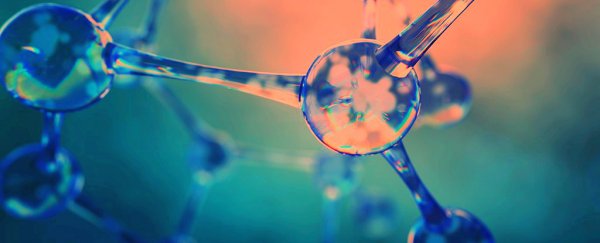Using a beam of light, chemists have figured out how to turn an asymmetrical molecule into a mirror image of itself, with the asymmetry on the other side.
To back up into basic chemistry, a molecule is what we call a particle made up of two or more atoms. For example, water is a molecule consisting of two hydrogen atoms and an oxygen atom, carbon dioxide is two oxygen atoms and a carbon atom, and so on.
Many molecules are symmetrical, but not all. And some of these asymmetrical molecules are exact mirror images of each other that cannot be superimposed.
Of course, molecules don't actually have tiny atom-scale hands, but chemists call this molecular asymmetry chirality, or even plain old handedness.
These chiral molecules can either be left-handed S-molecules (from 'sinister', the Latin word for 'left'), or right-handed R molecules (from 'rectus', the Latin word for 'right').
Now scientists have figured out how to turn an S-molecule into an R-molecule using a technique called excited state proton transfer.
 (Ken Hanson/Florida State University)
(Ken Hanson/Florida State University)
"This means we wouldn't have to throw half of a chemical solution away when we only want the right-handed molecules," explained chemist Ken Hanson of Florida State University.
Why would you have to throw half out? The thing is, chirality can be vitally important in pharmacology, as we found out to devastating effect in the late 1950s.
You may have heard of the thalidomide disaster. A new drug called thalidomide (C13H10N2O4) hit the market in 1957 as a safe sedative and morning sickness for pregnant women. It was sold around the world.
But when an increasing number of babies were born with birth defects following the introduction of this drug, in 1960 a paediatrician made the connection, and thalidomide was removed from pharmacy shelves. Around 120,000 pregnancies were affected - most ended in miscarriage - but 10,000 babies were born with deformities.
As it turned out, (R)-thalidomide was perfectly safe. It was (S)-thalidomide - the left-handed molecule - that was teratogenic, producing developmental defects in embryos.
While it isn't the case for all drugs, chirality can affect drug development, since chiral molecules can bind differently to target receptors. It's something chemists have taken into account in the wake of the thalidomide disaster.
That's why being able to switch chirality would be a powerful tool for producing drug molecules that all have the same handedness.
For this research, the team experimented on an organic molecule called BINOL, popular in synthetic organic chemistry for the development of a wide range of asymmetric catalytic reactions. The effectiveness of these reactions relies on the purity of the left- or right-handedness of the BINOL.
The team attached a left-handed amino acid to the BINOL, and directed a beam of blacklight at it. After 60 minutes, what had been a 50-50 mix of (R)- and (S)-BINOL had 59 percent more (R)- than (S)-BINOL.
Obviously that means the sample wasn't pure (R)-BINOL, but the experiment was intended as a proof of concept to determine if the technique could actually work.
Now that this has been demonstrated, the team will be working to refine it in the hopes of producing a more pure sample.
The team's research has been published in the journal Chemical Communications.
